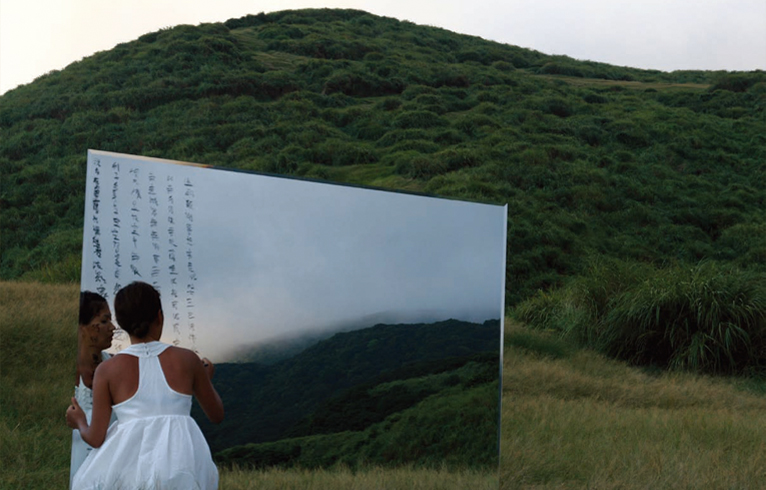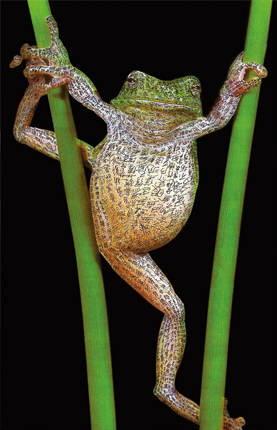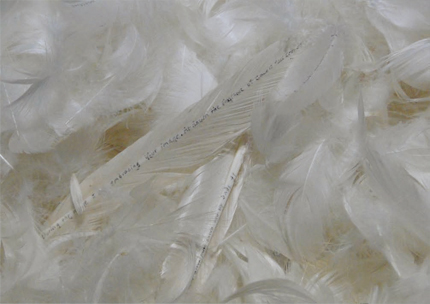STOPPING FOR A MOMENT: THE ART OF CHARWEI TSAI
| April 7, 2012 | Post In LEAP 13

FOR HER MOST recent work Charwei Tsai has amassed a large pile of white feathers. The pile is placed on a circular mirror and heaped up to about half a meter high and one meter across. Down is mixed with wing feathers to make the whole pile seem fluffy and insubstantial. Were this not inside an art gallery, the wind would blow it away. As the viewer gets closer, she begins to notice that inscribed on the spines of some of the feathers is writing. The writing is miniscule: only those with good eyesight or who carry a magnifying glass with them can read it. So, one realizes, it is not just a pile of feathers but also a pile of language. That term “pile of language” recalls a famous drawing, A Heap of Language, made by American land and conceptual artist Robert Smithson in 1966, in which he wrote on a sheet of graph paper 20 lines of text beginning at the bottom with “hieroglyphic neologic word coiner angst…” each line getting shorter so as to form a heap or pyramid with the single word at the apex “language.” In contrast to Smithson’s rather academic-looking exercise, Tsai’s work is highly sensual, and when we finally, if our eyesight is good enough, decipher her miniscule script, we find something very different from the American’s listing of words about language: “During the night I am embracing your image. At dawn the fragrance… If love did not exist… The lute of my heart plays only one song.” These are phrases and sentences by the Sufi poet Rumi. Half-hidden as they are amongst the feathers, we can rarely read complete sentences. But we start to sense this mixture of heady eroticism and yearning: an eroticism and yearning that could be as much a love for God as for another person.
The feathers and down are rejects from a pillow shop— they were too large to be used as stuffing— and she has chosen white feathers because of white’s associations of purity. If Smithson’s work smells of the classroom, Tsai’s smells of either the dovecote or the bedroom. (Of course, associations are always slippery— at one time in Europe or America a white feather was a symbol of cowardice given out to young men who had not volunteered to fight in the First World War; at another time it became symbolic of peace. And of course, white is symbolic of death in China, unlike in the West where black is the funereal color.

The differences between the two works— from mid-century U.S. to contemporary Asia, from a male to a female artist, from the reductively conceptual to the sensuous but conceptually informed— are indicative of how art has changed in 45 years. One aspires to objectivity, the other to a richness of associations. Of course, we all know in Chinese culture writing is very different from what it is in the West. No one looking at Smithson’s work admires his calligraphy. It is functional, no more, much as a student’s lecture notes might be. Even if Tsai’s calligraphy is relatively unpretentious, it is still inevitably more personal and closer to drawing than if written in English. If both works aspire to the general statement, and arguably in her case to self-abnegation, hers is nonetheless more autographic. The actual act of writing in her piece is emphasized by the difficulty of writing on the quills. At the opening of the exhibition in which the work was first shown (held at Tina Keng Gallery in Taipei), she had not even completed the laborious task of writing all the aphorisms of Rumi she intended to. This did not bother her: to return to the gallery and continue the task periodically emphasized the performative nature of the work. Much as with prayer or chanting, the repetition of the act is important.
Who is Charwei Tsai?
She is an artist for whom the act of writing is key, but whose work has extended to sculpture, film and performance. Born and brought up in Taiwan and then educated in the U.S., her entry point to the art world was working as an assistant to Cai Guo-Qiang. It was he who recommended her for an exhibition at the Cartier Foundation in Paris in 2005. In that and other early exhibitions in Greece and Singapore, she became known for writing on tofu, meat, fish, frogs, lotus leaves, bulbs, and flowers. None of these materials or objects or beings was permanent: the tofu disintegrated during the exhibition, the meat rotted, the lotus flowers became desiccated, frogs, fish and octopi moved away, eventually swam, and hence washed off the ink. Even if they did not move they, too, would eventually inevitably die and rot like the tofu and the meat. Such impermanence mirrored the text she wrote out in these early works, for example the Buddhist Heart Sutra: “…form does not differ from emptiness: emptiness does not differ from form. Form itself is emptiness: emptiness itself is form.”
Later she came to regret writing on animals and sea creatures and determined not to do so again. Inevitably, given the texts she uses, ethical considerations became foremost in her work. Her shift to writing on a mirror and filming that action was partly a response to her unease at causing animals pain, but more importantly, it was a way to make visible the performative act of writing the sutra, an act that was simultaneously personal and ceremonial.
Dedicated to earth, sea, and sky and filmed with them as background, these three films were simple. In each we see her write the characters of the Heart Sutra in Chinese script on a mirror. The mirror reflects the sky, sea, or earth. As she writes, she slowly moves across the mirror and fills it with text. Clearly this meant as a silent equivalent of chanting the mantra. The wind tousles her hair and tugs at the white dresses she wears in each film. When the works were shown in Australia and subsequently in England in a university gallery, beanbags were provided so that students could sit down, relax, and chill out. The sight of someone writing was relaxing; for some more so, as the writer was beautiful. The subdued background sound of waves rolling in on the shore enhanced the calm, relaxing and therapeutic atmosphere of the gallery in which they were shown.

The performative and meditative aspect of such works is made more overt in her performances, such as that at Asia Pacific Triennale 6 in 2009. Here, with a group of Buddhist monks and nuns from Brisbane, she wrote the sutra on mushrooms that were left to dry out and wrinkle over the course of the exhibition.
She has talked of not being specifically religious and not being from a religious family, but of how she learnt this text as a child and has often spoken it aloud or to herself when she was scared or needed calming— much as a Christian might recite in danger the Psalm 23: “Yea, though I walk through the valley of the shadow of death, I will fear no evil: for thou art with me…”
That this is not hardcore religion may seem mystifying to some. Is this just designer mysticism? The affectation of an elegant young woman? However, the lie is given to this by the range of her work: in another project at a church in France, Tsai inscribed petals with lines from a text by Elaine Scarry on torture. In her spare time, she is the editor and publisher of a magazine of artists’ projects, Lovely Daze (see www.lovelydaze.com). She makes no pretense to being a nun or guru: she inhabits and enjoys being in society.
These works are not necessarily evangelizing Buddhism or Islam. She would rather insist on the underlying truths of all religions and the cross-cultural effect of meditation. It matters too that she performs these tasks in a matter-of-fact way, much as Richard Long walks across a landscape or On Kawara paints a date painting. They are about being and also reconnecting with nature—an issue in all the urbanized or urbanizing nations of the world.
Her works are, with their unusual materials, striking but appealing. Their elegance and poetry are emphasized by being in a private gallery. The preciousness, the sensuous quality, and the therapeutic effect of her works makes them attractive, however, to private collectors, but the way her work seeks above all to communicate with an audience (like her magazine) and even invite participation is better seen when shown as public art. Another video work Ah was first shown in Singapore in the subterranean corridor between a subway station, a shopping mall and a concert hall. As a soundtrack she had a choir singing the simple vowel “Ah”— a sound used in meditative practices in most world religions, whilst projected on the wall was a video of her writing the two letters in ink in water. As the water moved slowly back and forth the ink dispersed. The video was endlessly repeated— and in Singapore also shown on three projectors so as to cover a substantial length of wall. People walking down the corridor would slow down and stop, entranced or even, on occasion, join in the chanting.
Making no sectarian requirements of anyone— Buddhist, Muslim, Christian or atheist— the work acted much like a shrine or wayside temple for our contemporary society: a moment of calm and beauty when rushing to work or to shop or to catch a train home. As in all her works, it encapsulated the apparent paradox inherent in her work of making a private act and a moment of personal calm both public and shared.

